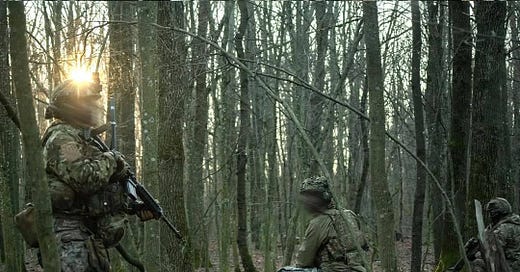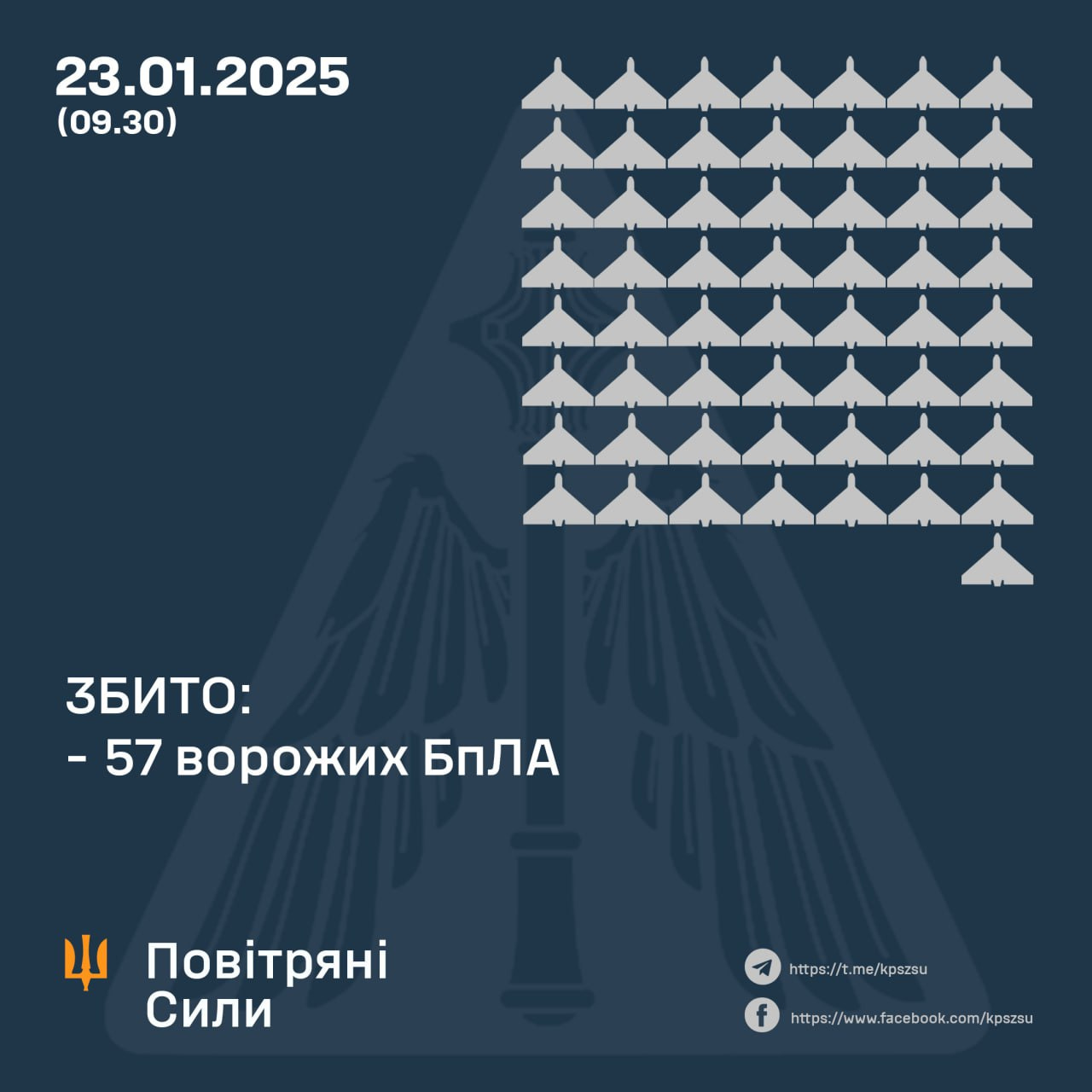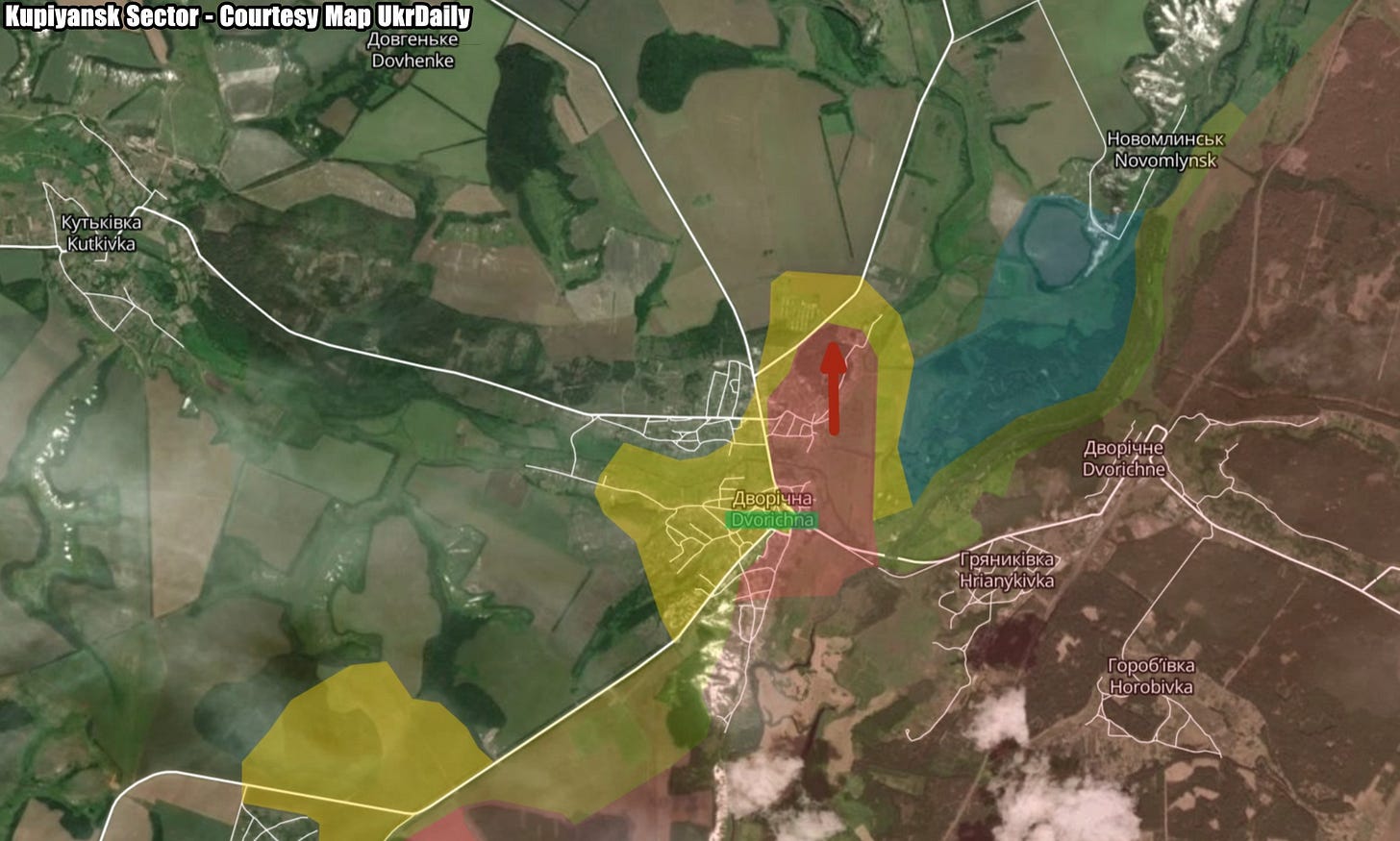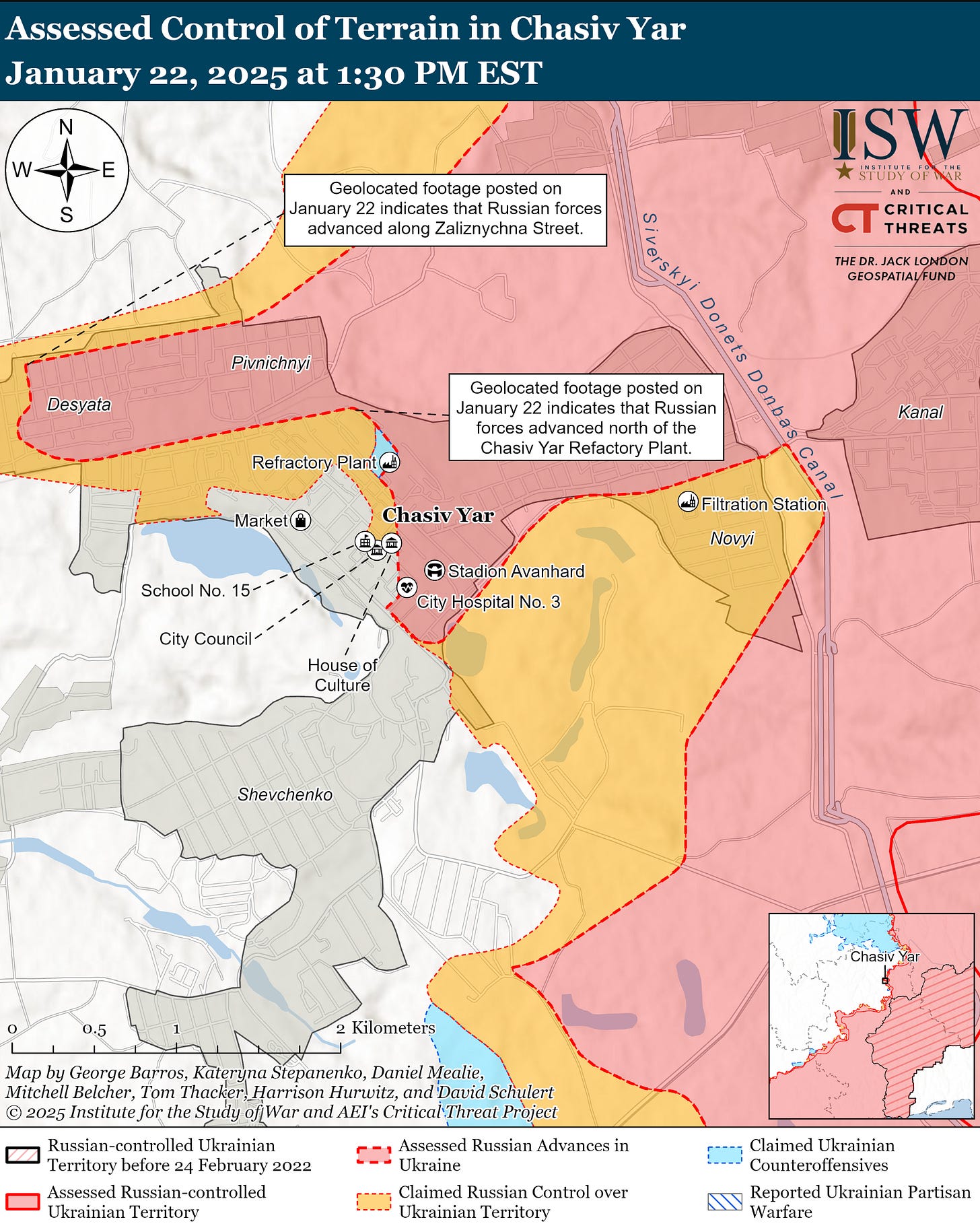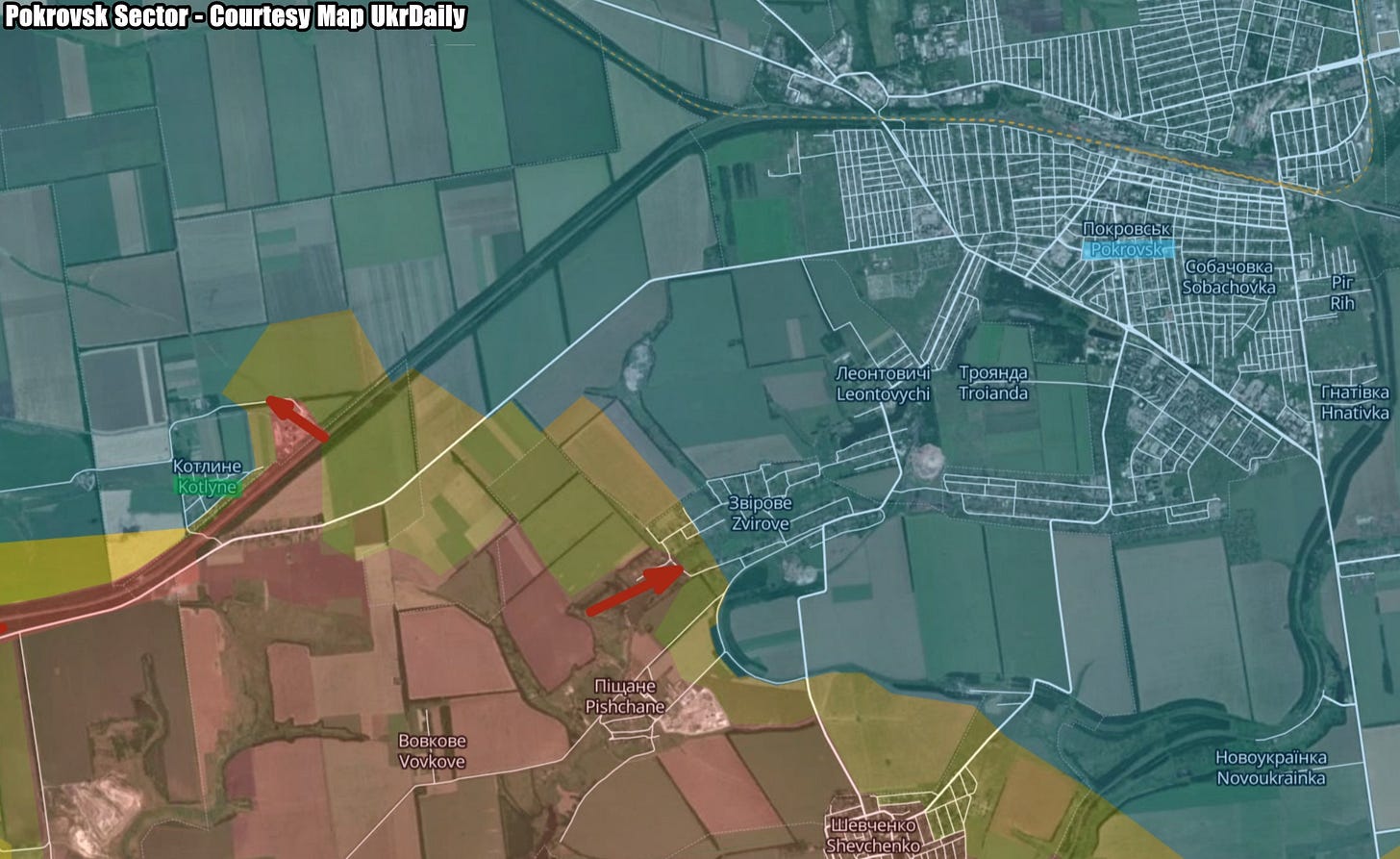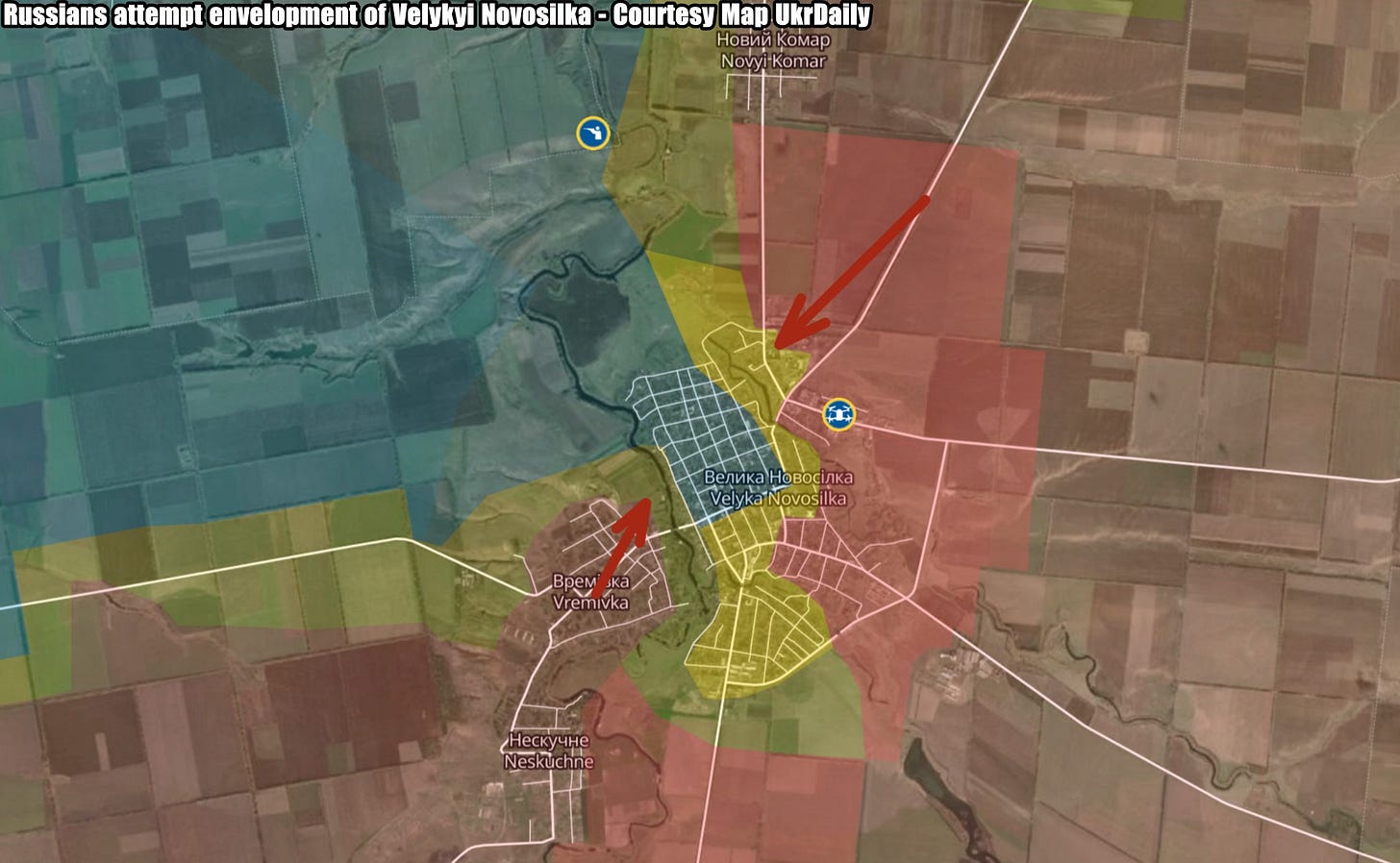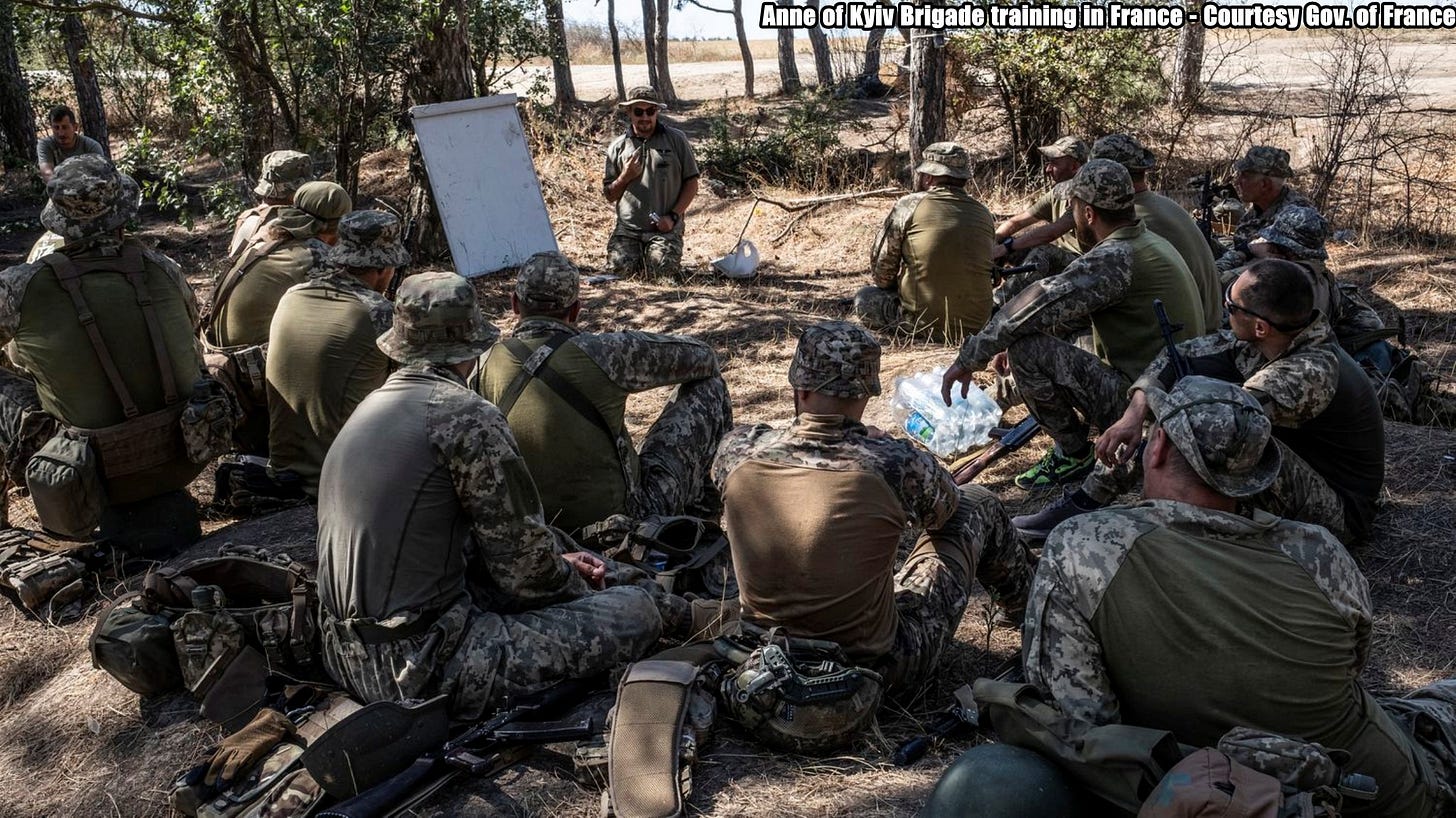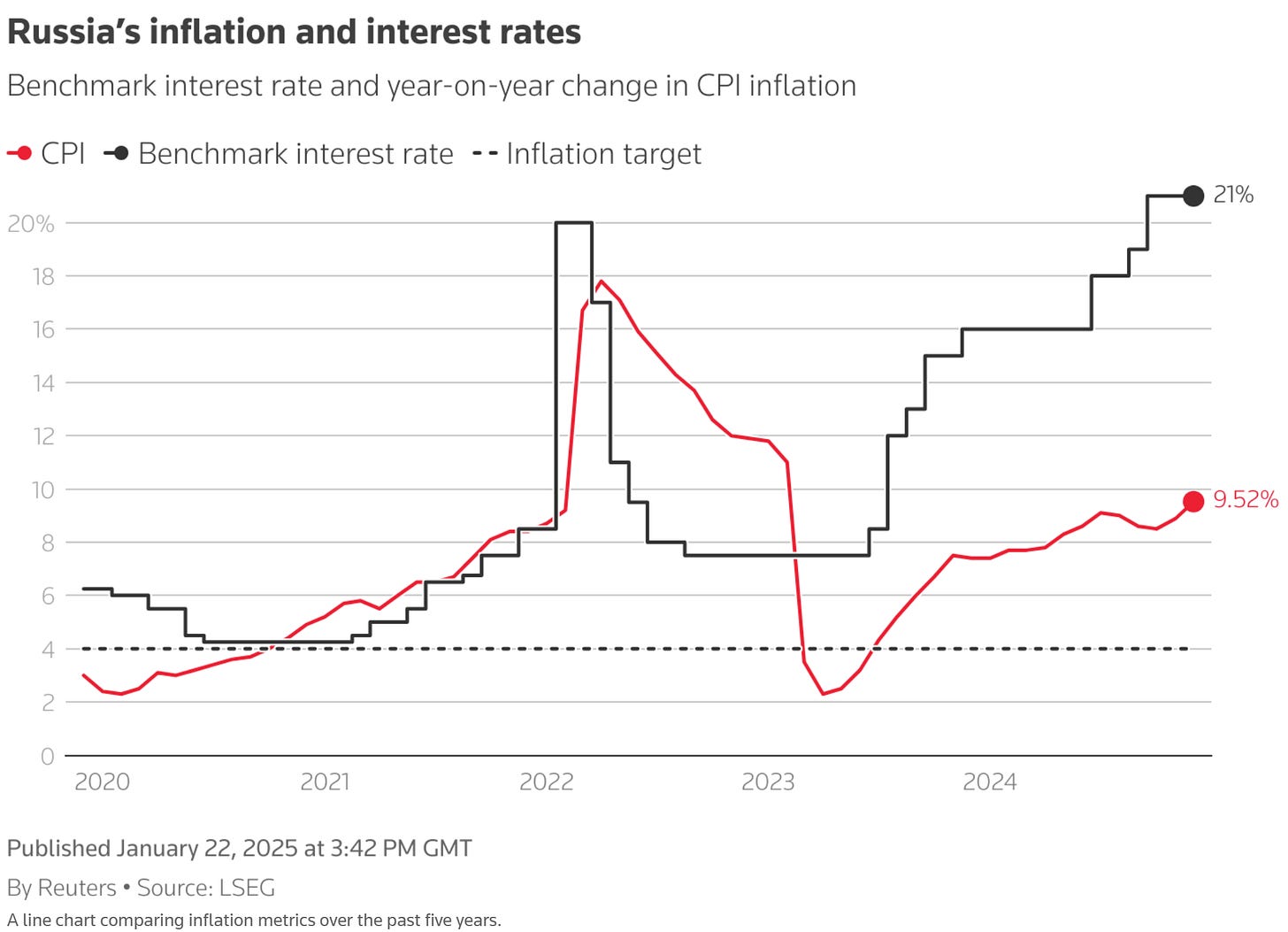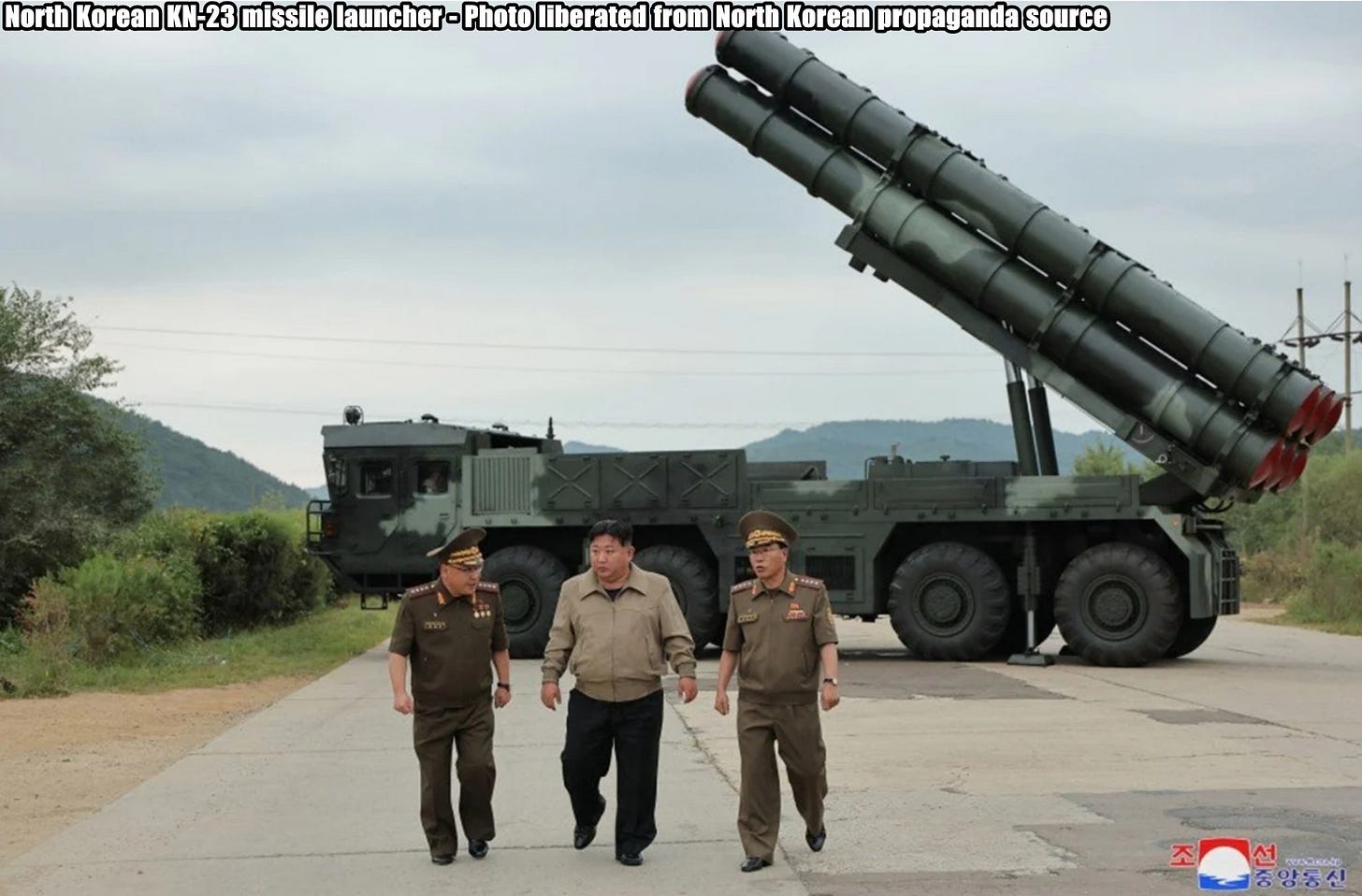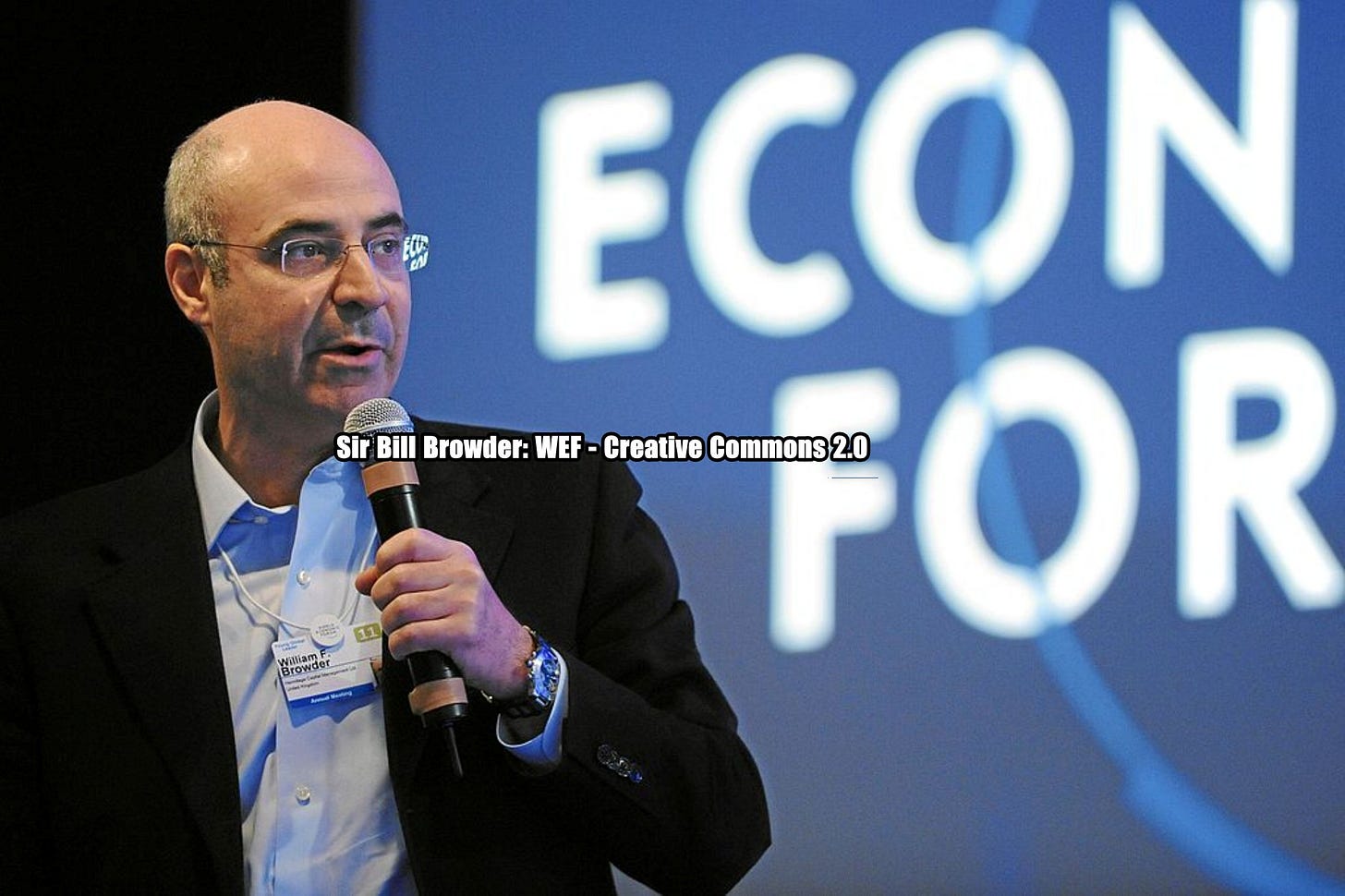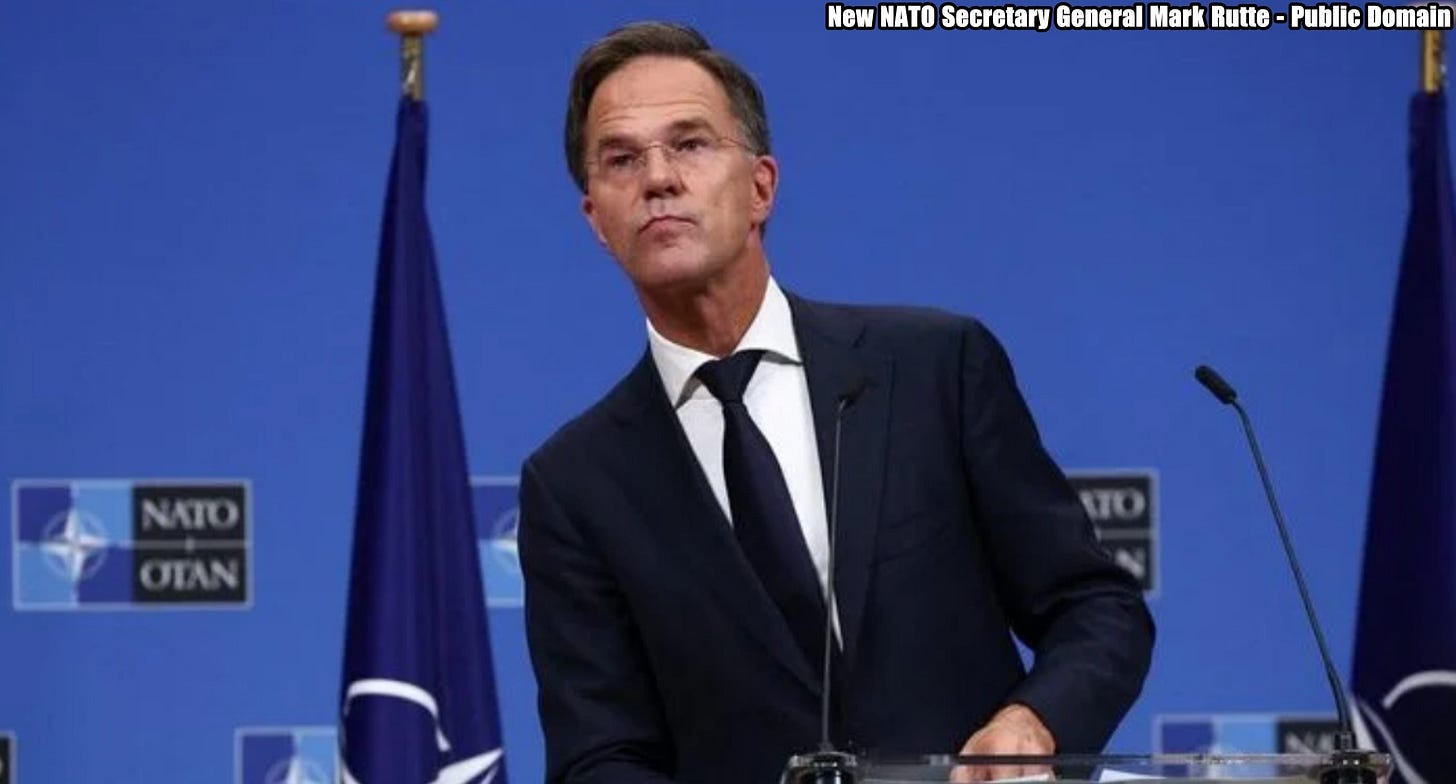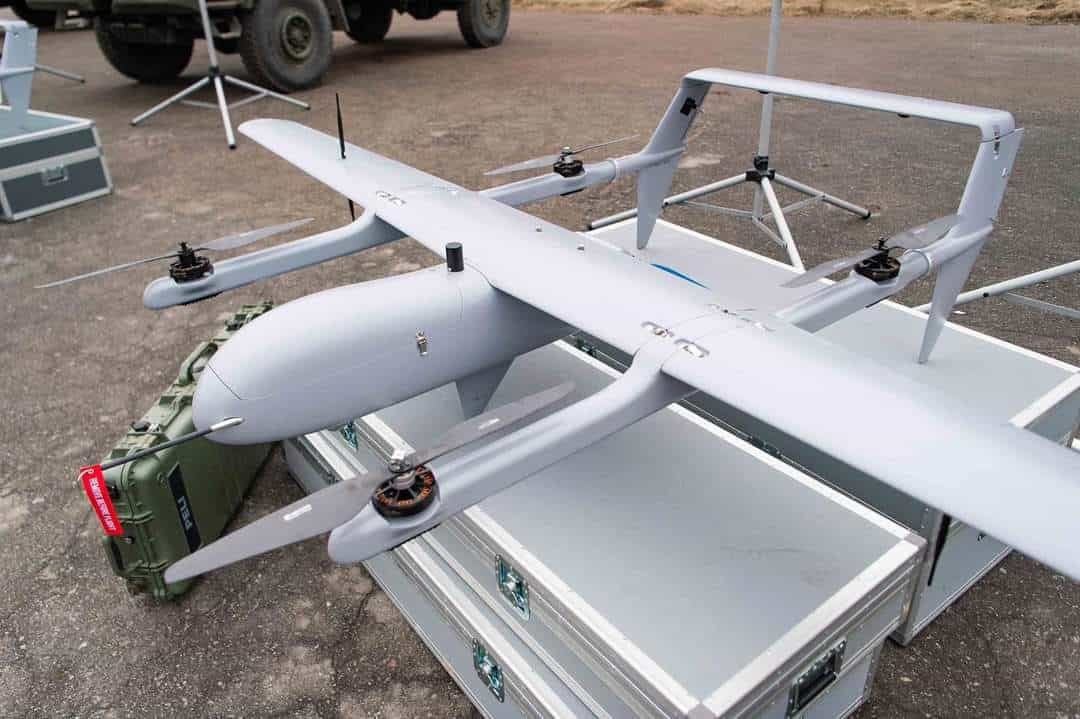Slava Ukraini! In early 2022 I began a Telegram channel aggregating news from a number of sources daily on the war in Ukraine. In June 2023 I began providing a daily draft for the Ukraine War Brief Podcast collecting news from over 70 sources daily, which formed the basis of the script. While the Podcast no longer exists I have continued to make this Brief available for my followers here on Substack for those who wish to keep up with the news from the war.
All the latest news on the Russo-Ukraine War 6 days per week
ALONG THE CONTACT LINE
GSAFU Morning Report
The General Staff of the Armed Forces of Ukraine in its Operational Information update at 08:00 on Jan 23 stated that day 1065 of the full-scale invasion of the Russian Federation against Ukraine had begun.
The situation on the line of combat remains tense in some sectors. Ukrainian defenders continue to actively counteract the Russian aggressor, causing them losses in personnel equipment and technology. Exhausting the enemy along the entire front line and continuing to disrupt the plans of Russian occupiers to advance deeper into the territory of Ukraine.
During the past day, 115 combat engagements took place.
Over the past 24 hours, the enemy carried out 2 missile strikes, 74 air strikes, used 2,487 drones and approximately 5,200 artillery strikes across the positions of Ukrainian forces and civilians.
Air Force Daily Report
57 ENEMY UAVS SHOT DOWN, 27 DRONES FAILED TO REACH THEIR TARGETS (LOCATIONALLY LOST)
➖➖➖➖➖➖➖➖➖
On the night of January 23, 2025 (from 19:00 on January 22), the enemy attacked with 92 Shahed attack UAVs and simulator drones of various types from the directions: Millerovo, Orel, Kursk, Bryansk, Primorsko-Akhtarsk - Russia, and also used 4 Iskander-M /KN -23 ballistic missiles from the Voronezh region on the city of Zaporizhzhia.
The air attack was repelled by anti-aircraft missile troops, electronic warfare units, and mobile fire groups of the Air Force and Defense Forces of Ukraine.
As of 09:30, it was confirmed that 57 Shahed attack UAVs and drones of other types were shot down in Poltava, Sumy, Kharkiv, Chernihiv, Mykolaiv, Kherson, Zaporizhia, and Dnipropetrovsk regions.
27 enemy drones-simulators — lost in location (without negative consequences). Three UAVs in the air — combat operation continues!
As a result of the enemy ballistic missile strike on the city of Zaporizhia, unfortunately, there are dead and wounded, enterprises, institutions, apartment buildings and private houses have been destroyed and damaged. Special services are eliminating the consequences, assistance is being provided to the victims. The Kharkiv region has also suffered due to the fall of downed enemy UAVs.
Combat Operations in the Russian Federation
The Institute for the Study of War (ISW), a US based think tank, in its Jan 22 Russian Offensive Campaign Assessment reported that Russian forces continued offensive operations along the Ukrainian salient in Kursk Oblast on Jan 22 but did not make confirmed advances. A Russian milblogger claimed that Russian forces reached the outskirts of Guyevo (south of Sudzha), but ISW has not observed evidence of this claim.Russian forces continued ground attacks northwest of Sudzha near Pogrebki and south of Sudzha near Makhnovka and in and west of Kurilovka. Russian milbloggers claimed that Ukrainian forces counterattacked near Makhnovka and northwest of Sudzha near Kruglenkoye. Elements of the Chechen "Zapad-Akhmat" Battalion are reportedly conducting reconnaissance operations near Russia's international border with Sumy Oblast. Elements of the Russian 106th Airborne (VDV) Division are reportedly operating a TOS-1A thermobaric artillery system in Kursk Oblast.
The Khortytsia operational-strategic group
(Responsible for the northeastern part of Ukraine. )
Kupyansk Sector: Ukrainian Khortytsia Group of Forces Spokesperson Major Viktor Trehubov stated on Jan 22 that Russian forces are attempting to cross the Oskil River near Dvorichna with small vessels - particularly small rubber boats - under the cover of night. Trehubov noted that Ukrainian drones are targeting Russian forces attempting to cross the Oskil River and hiding in windbreaks. Trehubov also stated that Russian forces conduct assaults on the west (right) bank of the Oskil River, have accumulated an unspecified amount of personnel, and have not established logistics across the Oskil River as the water has not frozen. A Ukrainian drone battalion commander operating in the Kupyansk direction stated on January 22 that Russian commanders are forcing infantry to attack despite poor weather conditions preventing the proper use of drone or armored vehicle support.
Chasiv Yar Sector: Russian forces recently advanced in the Chasiv Yar direction amid continued offensive operations in the area on Jan 22. Geolocated footage published on Jan 22 indicates that Russian forces recently advanced along Zaliznychna Street in northwestern Chasiv Yar and recently marginally advanced north and northwest of the Chasiv Yar Refractory Plant in central Chasiv Yar.
Toretsk Sector: Ukrainian and Russian forces recently advanced in the Toretsk direction amid continued offensive operations in the area on Jan 22. Geolocated footage published on Jan 22 shows drone operators of the Russian 9th Motorized Rifle Brigade (51st Combined Arms Army [CAA], formerly the 1st Donetsk People’s Republic Army Corps [DNR AC]) striking Ukrainian forces in western Shcherbynivka (west of Toretsk), indicating that Ukrainian forces recently regained lost positions in the area. Geolocated footage published on Jan 11 and geolocated on Jan 22 indicates that Russian forces advanced along Kachalova and Puzanova streets in northern Toretsk.
The commander of a Ukrainian battalion operating in the Toretsk direction stated on Jan 22 that Ukrainian forces are defending in limited positions in Toretsk and trying to contain Russian forces in the settlement. Russian forces continued ground attacks within Toretsk itself on Jan 21 and 22
The Tavria operational-strategic group
(Responsible for the central-eastern and southeastern part of Ukraine.)
Pokrovsk Sector : Russian forces recently advanced southwest of Pokrovsk amid ongoing offensive operations near Pokrovsk on Jan 22. Geolocated footage published on Jan 22 indicate that Russian forces recently advanced in the fields northeast of Kotlyne (southwest of Pokrovsk) and within the northeastern part of the settlement.
Ukrainian military observer Kostyantyn Mashovets stated that Russian forces recently introduced elements of the 30th Motorized Rifle Brigade (2nd CAA, Central Military District [CMD]) to offensive operations south of Pokrovsk, indicating that Russian forces continue to prioritize the envelopment of Pokrovsk from the southwest. Mashovets assessed that Russian advances south and east of Pokrovsk have slowed in recent weeks.
Kurakhove Sector: Russian forces recently advanced west of Kurakhove amid continued offensive operations in the Kurakhove direction on Jan 22. Geolocated footage published on Jan 21 indicates that Russian forces recently marginally advanced in the fields south of Dachne (west of Kurakhove).
Velyka Novosilka Sector: Russian forces recently advanced near and within Velyka Novosilka amid continued offensive operations in the area on Jan 22. Geolocated footage published on Jan 21 and 22 indicates that Russian forces recently advanced along a road west of Rozdolne (northeast of Velyka Novosilka) and along Horizhnia Street in northeastern Velyka Novosilka.
There is a risk of operational encirclement of units in the Velykyi Novosilka sector.
Viktor Tregubov, spokesman of the Operational-Strategic Group "Hortytsia" stated that there is a risk of operational encirclement of units in the Velykyi Novosilka sector. Ukrinform reports.
"There has been no full envelopment there. There is a risk of an operational envelopment, but efforts are being made to prevent it and to prevent the Russians from blocking approaches to the village, although they are trying to take them under fire control, "Tregubov said.
According to him, special difficulties create the geographical location of the Velykyi Novosilka, namely: a river that crosses the village and limits maneuvers. Action plans are also being developed to level these difficulties, the spokesman added.
He also noted that in this direction, as in many others, Russian forces have an advantage, in particular in manpower.
"They are constantly rotating one way or another, "overflowing" personnel, replenishing the forces that are already there, they still have this resource. It is not as much in surplus as before, the spokesman said.
The Odesa operational-strategic group
(Responsible for Kherson, Qırım, (also known as Crimea) and the Black Sea.)
There have been no major changes to the combat environment since our last report.
TEMPORARILY OCCUPIED TERRITORIES
Nothing major to report.
THE HOME FRONT
Russian missile attack in Zaporizhzhia kills 1, injures at least 45, including infant
Russia attacked the city of Zaporizhzhia with missiles and drones in the early hours of Jan. 23, killing one person and injuring at least 45 others, Zaporizhzhia Oblast Governor Ivan Fedorov reported on Telegram.
A 47-year-old man was killed in the missile strike, Fedorov said. The attack left 45 more people wounded. At least 22 of them have been hospitalized, including a two-months old baby, according to the governor.
At least four of the injured victims are employees of Ukraine's State Emergency Service, Fedorov said. They have also been hospitalized.
One multi-story apartment building was destroyed and 30 were damaged in the city, in addition to damaged houses and non-residential buildings. Rescue operations are ongoing at the site as emergency workers search for victims who may be trapped beneath the rubble.
According to Fedorov, at least four explosions occurred in Zaporizhzhia shortly after 4 a.m. local time. An aerial alert had recently been issued over the region due to the threat of ballistic missiles from Russia.
Russia launched four Iskander-M or North Korean KN-23 ballistic missiles against the city, the Air Force reported.
Zaporizhzhia, home to approximately 710,000 residents before Russia's full-scale invasion in 2022, is frequently targeted by Russian forces. An attack against an industrial facility in the city on Jan. 8 killed 13 people and injured 122, including a child.
Syrskyi sees 'gradual' improvement in the scandal-hit French-trained brigade.
Commander-in-Chief Oleksandr Syrskyi said on Jan. 23 that the French-trained 155th "Anne of Kyiv" Brigade is "gradually acquiring certain combat capabilities" after reports of poor command and training. The Kyiv Independent reports.
The unit became a center of controversy after the Censor.net outlet uncovered rampant cases of mismanagement that led to high rates of losses and desertions. The brigade was deployed at the Pokrovsk sector, the most critical section of the front in Donetsk Oblast, in November 2024.
"All negative aspects and difficulties that arose during... (the brigade’s) deployment in Ukraine have been analyzed, and the conclusions will be taken into account during the further training of service members," Syrskyi said after discussion with officers during his visit to the Pokrovsk sector.
Censor.net's chief editor, Yurii Butusov, laid the blame for the brigade's poor performance on the Ukrainian military and political leadership, saying that France provided all the necessary support .
Similarly, Syrskyi thanked France for being "the first country to respond to the request to create a mechanized brigade and fulfilled all its obligations regarding the training and equipment."
The scandal cast doubt on Ukraine's initiative to build fresh new brigades that would be trained and supplied with the support of Western partners. The 155th Brigade was to be the flagship unit of this project.
Ukrainian authorities have launched an investigation into the brigade's mismanagement, with its former commander being reportedly detained earlier this week.
RUSSIAN WORLD
Putin grows concerned by Russia’s economy, as Trump pushes for Ukraine deal.
President Vladimir Putin has grown increasingly concerned about distortions in Russia's wartime economy, just as Donald Trump pushes for an end to the Ukraine conflict, Reuters reports citing five sources with knowledge of the situation.
Russia's economy, driven by exports of oil, gas and minerals, grew robustly over the past two years despite multiple rounds of Western sanctions imposed after its invasion of Ukraine in 2022.
But domestic activity has become strained in recent months by labour shortages and high interest rates introduced to tackle inflation, which has accelerated under record military spending.
That has contributed to the view within a section of the Russian elite that a negotiated settlement to the war is desirable, according to two of the sources familiar with thinking in the Kremlin.
This week Trump has said more sanctions, as well as tariffs, on Russia are likely unless Putin negotiates, adding that Russia was heading for "big trouble" in the economy. A senior Kremlin aide said on Tuesday that Russia had so far received no specific proposals for talks.
"Russia, of course, is economically interested in negotiating a diplomatic end to the conflict," Oleg Vyugin, former deputy chairman of the Central Bank of Russia said in an interview, citing the risk of growing economic distortions as Russia turbo-charges military and defence spending.
Vyugin was not one of the five sources, who all spoke on condition of anonymity due to the sensitivity of the situation in Russia. The extent of Putin's concerns about the economy, described by the sources, and the influence of that on views within the Kremlin about the war, are documented here for the first time.
Reuters has previously reported that Putin is ready to discuss ceasefire options with Trump but that Russia's territorial gains in Ukraine must be accepted and that Ukraine must drop its bid to join the U.S-led NATO military alliance.
Kremlin spokesman Dmitry Peskov, when asked about the Reuters reporting, acknowledged "problematic factors" in the economy, but said it was developing at a high rate and was able to meet "all military requirements incrementally" as well as all welfare and social needs.
"There are problems, but unfortunately, problems are now the companions of almost all countries of the world," he said. "The situation is assessed as stable, and there is a margin of safety."
Trump "is focused on ending this brutal war," by engaging a wide range of stakeholders, White House National Security Council spokesperson Brian Hughes said in response to Reuters' questions. In recent weeks, Trump's advisers have walked back his boast that the three-year-old war could be resolved in a day.
Just days before Trump's inauguration, outgoing U.S. president Joe Biden's administration imposed the broadest package of sanctions to so far target Russia's oil and gas revenues, a move that Biden's national security adviser, Jake Sullivan, said, opens new tab would give Trump leverage in any talks by applying economic pressure on Russia.
Putin has said that Russia can fight on as long as it takes and that Moscow will never bow before another power over key national interests.
Russia's $2.2 trillion economy had until recently shown remarkable endurance during the war, and Putin has praised top economic officials and business for circumventing the most stringent Western sanctions ever imposed on a major economy.
After contracting in 2022, Russia's GDP grew faster than the European Union and the United States in 2023 and 2024. This year, however, the central bank and the International Monetary Fund forecast sub-1.5% growth, although the government projects a slightly rosier outlook.
Inflation has edged toward double digits despite the central bank hiking the benchmark interest rate to 21% in October.
"There are some issues here, namely inflation, a certain overheating of the economy," Putin said in an annual news conference on Dec. 19. "The government and the central bank are already tasked with bringing the tempo down," he said.
Putin believes key war goals have already been met, including control of land that connects mainland Russia to Crimea, and weakening Ukraine's military, said one of the sources familiar with thinking in the Kremlin.
The Russian president also recognizes the strain the war is putting on the economy, the source said, citing "really big problems" such as the impact of the high interest rate on non-military businesses and industry.
Russia has hiked defence spending to a post-Soviet high of 6.3% of GDP this year, accounting for a third of budget expenditure. The spending has been inflationary. Along with wartime labour shortages, it has driven wages higher.
On top of that, the government has sought higher tax revenues to reduce the fiscal deficit.
Vyugin, the former deputy governor, said sustained high rates would put pressure on the balance sheets of businesses and banks.
Putin's frustration was evident at a Kremlin meeting with business leaders the evening of Dec. 16, where he scolded top economic officials, according to two of the sources, who have knowledge of discussions about the economy in the Kremlin and government.
One of the sources, who was briefed after the meeting, was told Putin was visibly displeased after hearing private investment was being cut because of the cost of credit.
The Kremlin released Putin's introductory comments praising business but did not identify any of the business participants at the mostly closed-door meeting. Reuters confirmed with one source that Central Bank Governor Elvira Nabiullina was not present.
Some of Russia's most powerful businessmen, including Rosneft CEO Igor Sechin, Rostec CEO Sergei Chemezov, aluminium tycoon Oleg Deripaska and Alexei Mordashov, the largest shareholder in steel-maker Severstal, have publicly criticised the high interest rates.
Nabiullina has faced pressure not to raise rates further from two of Russia's most powerful bankers - her former boss, Sberbank CEO German Gref, and VTB CEO Andrei Kostin - who feared that Russia was heading towards stagflation, one source with knowledge of discussions about the economy said.
Nabiullina, a former economic aide to Putin who also served as his economy minister, is one of Russia's most powerful women: she has served as central bank governor since June 2013 and three of the sources said that Putin trusts her.
Her supporters say critics miss the underlying cause of the inflation - the vast spending on the war - and say that without her, economic stability would have be threatened.
Russia to receive expanded arms shipment from North Korea
North Korea plans to deliver at least 150 KN-23 short-range ballistic missiles, additional artillery shells, and weapons systems to Russia in 2025, Defence Blog reports citing Kirill Budanov, the head of Ukraine’s Main Intelligence Directorate (HUR).
“Artillery is being used to support both North Korean and Russian operations, while the missiles are intended solely for Russian objectives,” Budanov told The War Zone in an interview, detailing the scale of the planned arms transfer.
Budanov disclosed that North Korea has already supplied Russia with approximately 120 M1989 “Koksan” self-propelled howitzers (170mm) and 120 M-1991 multiple rocket launchers (240mm) over the past three months. He added that a similar volume of artillery systems could be expected in the near future.
Additionally, North Korean KN-23 ballistic missiles—modeled after the Russian Iskander missile and capable of carrying either conventional or nuclear payloads—are already being used by Russian forces.
“Most of this weaponry is being employed against Ukrainian forces or for training exercises in Russia,” Budanov explained.
According to Budanov, North Korea’s military aid has implications beyond just hardware. There is a possibility that Pyongyang could send infantry reinforcements to Russia’s Kursk region in 2025, though their operational effectiveness remains in question.
“We don’t expect to see a significant influx of new ground forces. Their [North Korean soldiers’] role is more symbolic, akin to biological robots,” Budanov said, casting doubt on their ability to shift the battlefield dynamics.
The weapons transfers and potential deployment of North Korean troops signal deepening military cooperation between Pyongyang and Moscow, which have grown closer in the wake of international sanctions and diplomatic isolation. For Russia, North Korea provides a vital source of artillery shells and other munitions at a time when its domestic production has struggled to meet the demands of its war effort.
The KN-23 missiles in particular are seen as a valuable addition to Russia’s arsenal, offering advanced capabilities, including precision targeting and evasion of missile defense systems.
INTERNATIONAL NEWS
Britain and EU face migrant crisis unless Russian assets are seized, warns US financier.
Ukrainian capitulation will prompt mass exodus of refugees, says Sir Bill Browder
Europe and the UK face a fresh immigration crisis unless $300bn (£244bn) of frozen Russian assets are seized and handed to Ukraine, the financier Sir Bill Browder has warned. The Telegraph reported on Jan 20.
Speaking on the fringes of the World Economic Forum meeting in Davos, Switzerland, Sir Bill said that the funds would allow Ukraine to defend itself for a further three or four years without having to rely on any additional Western military aid.
Donald Trump has made ending the war in Ukraine a top priority, but fears are growing of a shabby compromise that would force Ukraine to cede territory and fail to satisfy European security concerns.
Sir Bill, who founded the hedge fund Hermitage Capital Management, said Ukrainian capitulation would prompt a mass exodus of refugees and encourage Vladimir Putin into further aggression in the Baltic states and beyond.
It would also force European nations into dramatic increases in defence spending at a time of growing pressure on government budgets.
He said: “The main leverage that Donald Trump has in forcing a settlement on Ukraine is the idea that he can dictate terms by withdrawing US funding for the war.
“The crux of the matter is that there’s no reason why Trump should have all this leverage when there’s $300bn Russian Central Bank reserves sitting in western central banks, most of which is in the UK and Europe.
“That money should be quickly confiscated and handed to Ukraine, so that it’s not Donald Trump determining their future. If forced into a total capitulation, we are going to end up in Western Europe, in the UK, with 15-20m refugees.
“And we’re also going to end up in a situation where Putin will then make a move on Estonia.”
G7 nations have already agreed to seize the interest on the $300bn and apply the funds to Ukrainian aid, but long-standing concerns over the legality of confiscating the principle has so far frustrated attempts to go further.
Both the UK and Mr Trump’s predecessor, Joe Biden, were broadly onside with these suggestions, but there is general agreement that the seizure cannot be done unilaterally. In addition, a looming election in Germany has proven impossible to secure wider European backing.
Any such seizure would require the support of all 27 EU members, some of which are openly sympathetic to Putin and could veto any deal.
There is also concern that Mr Trump too would veto the seizure in view of his long-stated determination to be the political leader who secures a peace settlement.
Volodymyr Zelenskyy, Ukraine’s president, is expected to back urgent action to confiscate the reserves when he addresses Davos participants later this week.
Sir Bill added: “Trump shouldn’t be telling us what to do. We should be grabbing this money.
“And if Ukraine wants to settle the war, they’re fully within their rights to do so, but on terms that they want to accept.”
NATO chief Rutte says Europe will pay for US arms for Ukraine.
NATO Secretary General Mark Rutte on Thursday urged the United States to keep supplying Ukraine with weapons to fight Russia's invasion and said he was sure Europe was ready to pay the bill, Reuters reports.
Speaking at the World Economic Forum in Davos, the NATO chief said Europe must invest more in defence, ramp up arms production and take a bigger share of spending on Ukraine aid.
His comments came after U.S. President Donald Trump said earlier this week that the European Union should be doing more to support Ukraine.
"On Ukraine, we need the U.S. also to stay involved," Rutte said.
"If this new Trump administration is willing to keep on supplying Ukraine from its defence industrial base, the bill will be paid by the Europeans, I'm absolutely convinced of this, we have to be willing to do that," he added.
He said Trump was right to say Europe should be paying more to help Ukraine win the war as "it is a worldwide conflict, yes, but still Ukraine is closer to Europe than to the U.S."
Asked to elaborate on his comments, Rutte told Reuters in Davos that if the U.S. keeps supplying arms to Ukraine, "then it is only fair that Europe will, in terms of the financial burden of those deliveries, pay the highest burden".
He did not put a figure on how much Europe would pay or say whether he had agreement from European leaders on the matter.
Trump's envoy for special missions, Richard Grenell, weighed in remotely on the Davos panel, which included Rutte, taking a swipe at the NATO secretary general, who previously served as Dutch prime minister and has supported NATO's position that Ukraine will become a member of the alliance in the future.
"The American people are the ones that are paying for the defence. You cannot ask the American people to expand the umbrella of NATO when the current members aren't paying their fair share - and that includes the Dutch, who need to step up," Grenell said.
In the panel discussion, Rutte said it was vital Russia did not win as it could result in Russian President Vladimir Putin "high fiving" the leaders of North Korea and China.
"We really have to step up and not scale back our support for Ukraine," the NATO chief said.
"The frontline is moving in the wrong direction," he said.
Russian cargo ship Sparta II docks in Syria after weeks drifting at sea.
A Russian cargo ship supposed to evacuate Russian military equipment from Russia's Tartus naval base in Syria has finally docked after spending weeks drifting in the Mediterranean,the Kyiv Independent reported citing MarineTraffic data on Jan. 22.
The Sparta II, a Russian cargo ship under U.S. sanctions, had been drifting near Tartus since Jan. 5 after leaving Baltiysk in Kaliningrad Oblast on Dec. 11.
Following the December overthrow of Russian-backed dictator Bashar al-Assad by rebel forces, the new Syrian authorities refused to grant entry to the ship.
Reports indicate that Russian forces have dismantled air defense radars and moved over 100 trucks of equipment to the port, but without access for Russian ships, personnel and equipment had been left stranded.
The Insider reported on Jan. 21 that Syrian authorities had finally granted permission for the ship to dock, and MarineTraffic data shows it moored at Tartus as of Jan. 23.
But while Russia may now be able to evacuate some of its personnel and equipment, the Kremlin's long term presence at the Mediterranean port was thrown into doubt earlier this week when Syria canceled Russia's 49-year operating lease for Tartus.
The contract, signed in 2019, had committed Moscow to invest at least $500 million in modernizing the port.
With the agreement now void, all revenues from the port's operations will go directly to the Syrian state, and its management will revert to local authorities.
MILITARY & TECH
Poseidon Drones Approved for Combat: Ukraine Expands Its Aerial Capabilities
Ukraine’s Defense Ministry has officially approved the domestically produced Poseidon unmanned aerial vehicle system for use in the Armed Forces.
Poseidon is designed to carry out a range of specialized missions.The UAVs within the system are equipped with electric motors and an advanced navigation system, allowing them to operate in temperatures from -20°C to +45°C and withstand strong winds, the ministry announced.
“The battery charge provides several hours of continuous operation. These UAVs operate at altitudes beyond the reach of many enemy air defense systems,” stated Deputy Defense Minister of Ukraine, Dmytro Klimenkov.
The Ukrainian military has been deploying these drones against Russian invaders since the summer of 2022.
That’s it for today’s Brief folks if you would like to keep up with events in Ukraine daily please consider subscribing, it’s free!


